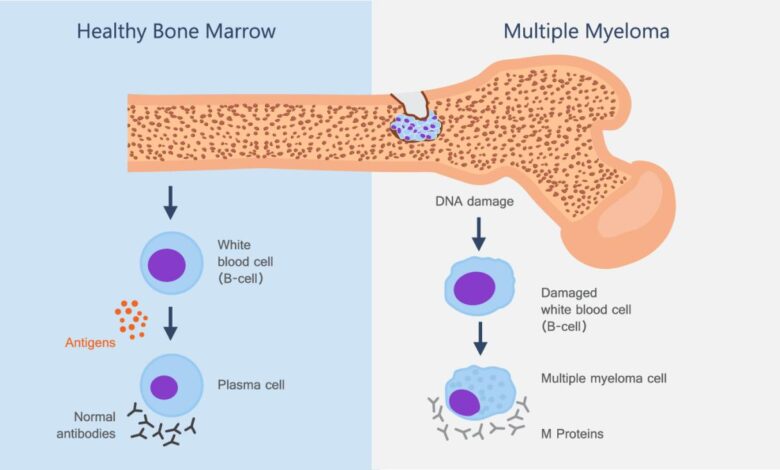
Multiple myeloma bone cancer is a devastating disease that affects the skeletal system, impacting patients’ lives in profound ways. This comprehensive guide explores the complexities of this condition, from its biological mechanisms to treatment strategies and patient support. We delve into the various types of bone lesions, common symptoms, and diagnostic procedures, providing a holistic understanding of this often-overlooked aspect of myeloma.
The article delves into the biological mechanisms behind bone damage, exploring how myeloma cells disrupt normal bone remodeling. It details the different diagnostic methods, including imaging techniques and biopsies, and discusses various treatment approaches, from chemotherapy to targeted therapies. The guide also touches upon the crucial aspects of managing pain, preventing further bone damage, and supporting patients through their journey.
Introduction to Multiple Myeloma Bone Cancer

Multiple myeloma is a cancer of plasma cells, a type of white blood cell. This cancer, when affecting the bones, is known as multiple myeloma bone cancer. It’s characterized by the uncontrolled proliferation of these abnormal plasma cells in the bone marrow, which subsequently disrupts the normal function of the bone. This disruption leads to a variety of bone-related complications, including pain, fractures, and other significant health issues.The biological mechanisms behind the development of bone lesions in multiple myeloma are complex.
Abnormal plasma cells, called myeloma cells, produce proteins that interfere with bone remodeling. Bone remodeling is the natural process by which old bone is broken down and new bone is formed. Myeloma cells disrupt this process by stimulating the breakdown of bone faster than the body can rebuild it. This imbalance results in weakened and damaged bones, making them more susceptible to fractures and pain.
Types of Bone Lesions
Multiple myeloma bone lesions manifest in various forms. They can appear as lytic lesions, which are areas of bone destruction, or as blastic lesions, characterized by the overproduction of bone tissue. Furthermore, mixed lesions, combining both lytic and blastic features, can also occur. The specific type of lesion and its location in the skeleton can vary greatly between individuals.
Common Symptoms and Signs
The common symptoms and signs of multiple myeloma bone cancer can include persistent bone pain, often located in the back, ribs, or hips. Pathological fractures, breaks in bones that occur spontaneously or from minimal trauma, are another significant indicator. Additionally, there might be swelling or tenderness in the affected areas. These symptoms can be exacerbated by physical activity.
Stages of Multiple Myeloma Bone Cancer Progression
Understanding the progression of multiple myeloma bone cancer is crucial for effective treatment planning. The following table provides a general framework for the stages, though individual progression can vary greatly.
| Stage | Description | Characteristics |
|---|---|---|
| Early Stage | The disease is localized to the bone marrow and hasn’t spread significantly to other parts of the body. | Symptoms may be mild or nonexistent. Bone scans may show minimal or localized areas of damage. |
| Intermediate Stage | The disease has spread to more bone sites or other organs, but the overall health of the patient is relatively stable. | Bone pain, fractures, and other symptoms become more pronounced. Blood tests and imaging studies reveal more widespread bone involvement. |
| Late Stage | The disease has significantly spread to various organs and bones. The patient’s overall health is severely compromised. | Symptoms are severe, and multiple fractures are likely. Other organ systems may show significant damage. |
Diagnosis and Assessment: Multiple Myeloma Bone Cancer
Unveiling the presence of multiple myeloma bone cancer often requires a multi-faceted approach, combining various diagnostic tools and assessments. Understanding the specific procedures used, the role of imaging, and the importance of bone marrow biopsies provides a clearer picture of the disease’s progression and allows for more targeted treatment strategies. This journey begins with a careful evaluation of symptoms, followed by a series of diagnostic tests.
Diagnostic Procedures
The diagnostic process for multiple myeloma bone cancer involves a meticulous evaluation of symptoms, medical history, and physical examination, followed by a series of specialized tests. These tests are crucial in confirming the diagnosis, determining the extent of the disease, and guiding treatment decisions. The accuracy of these procedures directly impacts the effectiveness of the treatment plan.
Imaging Techniques
Imaging techniques play a vital role in detecting and assessing bone lesions associated with multiple myeloma. These techniques provide visual representations of the affected areas, enabling physicians to evaluate the extent of bone damage and identify potential areas of concern.
Multiple myeloma bone cancer is a tough disease, impacting countless lives. It’s heartbreaking to see how these kinds of conditions can strain individuals and families. The financial burdens associated with treatment can often be overwhelming, a bit like following the insulin price money trail, which often leads to a lot of questions about corporate responsibility. Exploring the financial aspects of healthcare, like following insulin price money trail , can help us understand the complexities of this challenging disease better.
Ultimately, these factors all contribute to the overall struggle of managing multiple myeloma bone cancer.
- X-rays are fundamental initial imaging tools. They reveal the presence of lytic lesions, which are areas of bone loss. These lesions often appear as radiolucent regions on X-rays, indicating bone destruction. Lytic lesions are a characteristic feature of multiple myeloma, and their presence can suggest the extent of the disease.
- Computed Tomography (CT) scans provide detailed cross-sectional views of the affected bones. CT scans enhance the visualization of bone lesions and can pinpoint their precise location and size. This precise information is crucial for surgical planning and guiding biopsy procedures.
- Magnetic Resonance Imaging (MRI) offers detailed information about the soft tissues surrounding the bone lesions. MRI is particularly useful for evaluating the extent of soft tissue involvement and identifying any associated complications.
Bone Marrow Biopsies
Bone marrow biopsies are essential for confirming the diagnosis of multiple myeloma. A bone marrow biopsy involves extracting a small sample of bone marrow from the hip bone. The sample is then analyzed under a microscope to identify the presence of abnormal plasma cells, which are characteristic of multiple myeloma. This procedure confirms the diagnosis and provides critical information about the disease’s characteristics.
Comparison of Imaging Modalities
Different imaging modalities offer varying levels of detail and information. The choice of modality depends on the specific clinical questions and the patient’s needs. A comprehensive approach often involves combining multiple imaging techniques for a more complete picture of the disease.
| Imaging Modality | Typical Findings in Multiple Myeloma Bone Cancer |
|---|---|
| X-rays | Lytic lesions (areas of bone loss), possible fractures |
| CT scans | Detailed visualization of bone lesions, assessment of extent and location, identification of possible involvement of surrounding structures |
| MRI | Assessment of soft tissue involvement, identification of edema or inflammation, differentiation between benign and malignant lesions |
Treatment Strategies
Managing multiple myeloma bone cancer involves a multifaceted approach targeting both the cancer cells and the bone damage they cause. Treatment strategies are tailored to individual patient needs, considering factors like the stage of the disease, overall health, and specific genetic characteristics of the myeloma cells. The goal is to control tumor growth, reduce bone pain and fracture risk, and improve quality of life.Different treatment options, including chemotherapy, targeted therapies, and bone-modifying agents, are often combined to maximize efficacy and minimize side effects.
Understanding the role of each approach is crucial for making informed decisions about treatment plans.
Chemotherapy Regimens
Chemotherapy drugs aim to kill myeloma cells throughout the body, including those in bone lesions. Different chemotherapy regimens are used depending on the specific characteristics of the myeloma and the patient’s overall health. These regimens often involve combinations of drugs, each with its own mechanism of action.
- VCyD: This regimen, commonly used in the treatment of multiple myeloma, combines the drugs bortezomib, cyclophosphamide, and dexamethasone. It is known for its effectiveness in achieving remission and controlling disease progression in many patients.
- RVD: This regimen, another widely used combination therapy, incorporates lenalidomide, bortezomib, and dexamethasone. Its effectiveness in treating multiple myeloma has been demonstrated in numerous clinical trials, often leading to significant responses.
- KRP: Carfilzomib, lenalidomide, and dexamethasone, a key component of this regimen, are targeted towards myeloma cells and their ability to damage bone tissue.
Targeted Therapies
Targeted therapies, designed to specifically attack myeloma cells, are increasingly used in combination with chemotherapy. These therapies often target specific proteins or pathways involved in the growth and survival of myeloma cells.
- Immunomodulatory drugs (IMiDs): These drugs, such as lenalidomide and pomalidomide, modulate the immune system to fight myeloma cells. They are often combined with other therapies to enhance their efficacy.
- Proteasome inhibitors: These drugs, such as bortezomib and carfilzomib, inhibit the function of the proteasome, a cellular component vital for myeloma cell survival. Their use often results in significant tumor reduction and extended remission.
Bone-Modifying Agents
Bone-modifying agents, including bisphosphonates and denosumab, are crucial in managing bone damage associated with multiple myeloma. They aim to reduce bone resorption, preventing further bone loss and fractures.
- Bisphosphonates: These drugs, such as zoledronic acid and pamidronate, are frequently used to prevent skeletal complications, including pain and fractures, by inhibiting osteoclast activity, the cells responsible for bone breakdown.
- Denosumab: This monoclonal antibody targets a protein essential for bone resorption. Its administration helps to preserve bone mass and decrease the risk of skeletal complications.
Efficacy Comparison
The efficacy of different chemotherapy regimens varies depending on factors such as the patient’s specific myeloma subtype and overall health. Clinical trials provide valuable data on the effectiveness of various combinations. However, the choice of regimen is ultimately made by the healthcare team based on individual patient characteristics.
Potential Side Effects
| Treatment Option | Common Side Effects | Less Common Side Effects |
|---|---|---|
| Chemotherapy (e.g., VCyD, RVD) | Nausea, fatigue, hair loss, infections | Neurotoxicity, peripheral neuropathy |
| Targeted Therapies (e.g., IMiDs) | Fatigue, constipation, skin rash, infections | Low blood cell counts, peripheral neuropathy |
| Bone-Modifying Agents | Gastrointestinal upset, muscle pain | Kidney problems, bone pain |
Management and Prevention

Managing multiple myeloma, especially its bone-related complications, is crucial for improving quality of life and overall prognosis. Effective management involves addressing bone pain, preventing further bone damage, and closely monitoring bone health. Supportive care plays a significant role in alleviating symptoms and enhancing patient comfort. By implementing preventive strategies, we can reduce the risk of skeletal complications and enhance the patient journey.Careful management of multiple myeloma encompasses a multifaceted approach, including pain relief, preventative measures, and regular monitoring of bone health.
A significant part of this strategy focuses on minimizing the impact of bone damage, a common and often debilitating complication. Bisphosphonates, a crucial class of medication, play a pivotal role in this process.
Managing Bone Pain
Bone pain is a common and often distressing symptom of multiple myeloma. Effective pain management strategies are vital for maintaining patient comfort and quality of life. These strategies may include over-the-counter pain relievers, stronger prescription medications, and physical therapies. A personalized pain management plan, developed in collaboration with the patient and healthcare team, is essential to ensure optimal symptom control.
Role of Bisphosphonates
Bisphosphonates are a class of medications that have proven highly effective in preventing further bone damage in multiple myeloma patients. They work by inhibiting bone resorption, the process where bone is broken down. By slowing this process, bisphosphonates help strengthen bone tissue and reduce the risk of fractures and skeletal complications. Alendronate, zoledronic acid, and pamidronate are examples of commonly used bisphosphonates.
Multiple myeloma bone cancer can be a tough battle, impacting overall health. Fortunately, maintaining a heart-healthy lifestyle, like eating a balanced diet and exercising regularly, can actually decrease your risk of various cancers, including myeloma. By focusing on how staying heart healthy will decrease your cancer risk , you’re indirectly strengthening your body’s defenses against this challenging disease.
This proactive approach is crucial in the fight against multiple myeloma bone cancer.
Regular Monitoring of Bone Health
Regular monitoring of bone health is essential for early detection of skeletal complications and for guiding treatment strategies. This includes periodic bone density scans (DEXA scans) to assess bone mineral density, and blood tests to monitor calcium and other relevant biomarkers. This proactive approach allows for early intervention, preventing severe complications. Monitoring allows for timely adjustments to treatment plans as needed.
Use of Supportive Care
Supportive care plays a crucial role in managing the various symptoms associated with multiple myeloma and its treatment. This encompasses a wide range of interventions, including nutritional support, physiotherapy, and counseling. Addressing fatigue, anxiety, and depression are crucial components of supportive care. These interventions enhance the patient’s overall well-being and contribute to improved quality of life.
Preventive Measures for Skeletal Complications
| Preventive Measure | Description |
|---|---|
| Regular DEXA Scans | Periodic bone density scans to monitor bone health and identify early signs of bone loss. |
| Bisphosphonate Therapy | Use of bisphosphonates to inhibit bone resorption, reducing the risk of fractures and skeletal complications. |
| Adequate Calcium and Vitamin D Intake | Maintaining sufficient levels of calcium and vitamin D to support bone health. |
| Fall Prevention Strategies | Implementing measures to reduce the risk of falls, particularly for patients at risk of fractures. |
| Physical Therapy | Exercises and physical therapy to improve strength, balance, and flexibility, minimizing risk of falls and fractures. |
| Nutritional Counseling | Guidance on a balanced diet rich in calcium and vitamin D, crucial for bone health. |
| Regular Monitoring of Blood Tests | Frequent monitoring of blood tests to assess bone markers and adjust treatment as needed. |
Patient Experience and Support
Living with multiple myeloma bone cancer can be profoundly challenging, impacting not only physical well-being but also emotional and social life. The diagnosis often brings a cascade of emotions, from fear and uncertainty to grief and anger. Navigating treatment, managing side effects, and adapting to lifestyle changes are crucial aspects of the patient journey. Understanding the emotional toll and access to support systems are essential for patients and their families to cope effectively.
Impact on Quality of Life
Multiple myeloma bone cancer significantly alters patients’ quality of life. The disease’s insidious nature, coupled with the side effects of treatment, can lead to fatigue, pain, and decreased mobility. These physical challenges often result in reduced activity levels, impacting social interactions and overall well-being. Furthermore, the emotional burden of a chronic illness, coupled with the uncertainties of treatment outcomes, can further diminish quality of life.
Psychological Support
Recognizing the emotional distress associated with multiple myeloma is crucial. Psychological support is essential for both patients and their families. Therapists, counselors, or support groups can provide a safe space to process emotions, address anxieties, and develop coping mechanisms. This support can help patients and their loved ones navigate the emotional rollercoaster of the disease and its treatment.
Professional guidance can also help patients and families manage stress, anxiety, and depression.
Support Groups
Support groups play a vital role in providing emotional and practical assistance to patients with multiple myeloma bone cancer. These groups offer a network of understanding individuals who have shared experiences. Members can offer encouragement, share coping strategies, and provide a sense of community. Practical assistance, such as advice on managing treatment side effects or finding resources, can also be invaluable.
Support groups create a space for patients to feel less isolated and more connected.
Available Resources
A multitude of resources are available to support patients with multiple myeloma bone cancer. These resources can offer practical assistance, emotional support, and access to information. They range from online platforms to local support organizations. These resources can be a lifesaver in helping patients navigate the complexities of their disease.
Table of Support Resources
| Resource | Description | Contact Information |
|---|---|---|
| American Cancer Society | Provides comprehensive information, support services, and resources for cancer patients and their families. | 1-800-227-2345 |
| National Multiple Myeloma Foundation | Dedicated to myeloma research, patient support, and advocacy. Offers educational materials, support groups, and access to specialists. | (212) 889-5044 |
| The Leukemia & Lymphoma Society | Provides support services, information, and resources for patients with blood cancers, including multiple myeloma. | 1-800-955-4572 |
| Local Support Groups (often through hospitals or community centers) | Offer a network of support, practical advice, and emotional encouragement. | Vary based on location; check with local hospitals or community centers. |
Illustrative Cases
Understanding multiple myeloma bone cancer through real-life examples helps contextualize the complexities of diagnosis, treatment, and long-term management. These case studies highlight the diverse presentations and challenges associated with this disease. They provide a framework for understanding how healthcare professionals approach individual cases and the potential outcomes.
Case Study 1: A 65-Year-Old Male
This case study details a 65-year-old male patient presenting with persistent back pain, fatigue, and recurrent infections. The patient’s medical history included a sedentary lifestyle and a family history of osteoporosis. Initial symptoms were attributed to musculoskeletal issues, delaying the accurate diagnosis.
| Stage | Description |
|---|---|
| Initial Presentation | Patient experienced persistent back pain, fatigue, and recurrent infections. Initial evaluation focused on musculoskeletal issues. |
| Diagnostic Process | A complete blood count revealed anemia and elevated levels of monoclonal immunoglobulin. Bone marrow biopsy confirmed the presence of plasma cell myeloma, consistent with multiple myeloma. Imaging (X-rays and MRI) showed lytic lesions in the spine. |
| Treatment Approach | Treatment involved a combination of chemotherapy (VTD regimen) and targeted therapy (Bortezomib) alongside supportive care for anemia and bone pain. The patient received regular monitoring of blood counts and bone health. |
| Patient Response | The patient responded well to the initial treatment regimen, showing a decrease in myeloma cells and an improvement in bone health. However, disease progression was observed after 18 months. |
| Long-Term Outcomes | The patient underwent a second-line treatment regimen, but the disease progressed, leading to a decline in overall health. The patient passed away after 3 years of diagnosis. |
| Challenges in Management | Delays in diagnosis due to misinterpretation of initial symptoms. The patient’s advanced age and co-morbidities influenced the treatment approach. The disease’s unpredictable nature presented challenges in long-term management. |
Diagnostic Process Overview
The diagnostic process for multiple myeloma often involves a series of tests to identify the presence of abnormal plasma cells, evaluate the extent of bone damage, and determine the specific type of myeloma. Blood tests (complete blood count, serum protein electrophoresis), bone marrow biopsy, and imaging (X-rays, MRI) are commonly used. The precise diagnosis requires a comprehensive evaluation, considering clinical presentation, laboratory findings, and imaging data.
Treatment Strategies and Outcomes
Treatment strategies for multiple myeloma often involve a combination of therapies, including chemotherapy, targeted therapy, and stem cell transplantation. The specific treatment plan depends on factors like the patient’s overall health, the stage of the disease, and the presence of any associated complications. Outcomes can vary greatly depending on these factors and the patient’s response to treatment. Unfortunately, multiple myeloma is a progressive disease, and while treatments can often manage symptoms and extend life, a cure is not always achievable.
Bone Health and Bone Cancer
Multiple myeloma, a cancer of the plasma cells, often leads to significant bone damage. Understanding the intricate relationship between bone health and the development of bone cancer in myeloma is crucial for effective diagnosis, treatment, and management. This connection isn’t simply a byproduct of the disease; it’s a complex interplay that impacts overall patient prognosis.The body’s bone tissue is in a constant state of remodeling, a dynamic process that involves the breakdown and rebuilding of bone.
This delicate balance is disrupted in multiple myeloma, contributing to the development of bone lesions and fractures. Understanding this process and the factors that influence it is vital for tailoring therapies and interventions.
Relationship Between Bone Health and Myeloma
The intricate relationship between bone health and myeloma involves several critical factors. Bone marrow, the site of blood cell production, is housed within the bone. When myeloma cells proliferate, they displace healthy bone marrow cells, impacting blood cell production. Furthermore, myeloma cells produce proteins that disrupt the normal balance of bone remodeling, leading to excessive bone resorption and decreased bone formation.
This imbalance is a primary driver of myeloma bone disease.
Bone Remodeling in Myeloma
Bone remodeling is a tightly regulated process involving osteoclasts (cells that break down bone) and osteoblasts (cells that build bone). In multiple myeloma, the dysregulation of this process is a hallmark of the disease. Myeloma cells release signaling molecules that stimulate osteoclast activity, leading to excessive bone resorption. Simultaneously, osteoblast activity is reduced, resulting in insufficient bone formation to compensate.
This imbalance results in weakened bones, increased risk of fractures, and pain.
Importance of Maintaining Healthy Bone Density
Maintaining healthy bone density is paramount in preventing and managing myeloma bone disease. Optimal bone density provides structural integrity and reduces the risk of fractures. Factors like adequate calcium and vitamin D intake, regular weight-bearing exercise, and appropriate medication can contribute to preserving bone health. In the context of myeloma, maintaining healthy bone density becomes even more critical, as it directly impacts the quality of life and overall prognosis.
Bone Microarchitecture and Myeloma Bone Disease
Bone microarchitecture, the intricate arrangement of bone tissue, plays a crucial role in determining bone strength and resistance to fracture. In myeloma, the disruption of bone remodeling results in altered bone microarchitecture. The trabecular (spongy) bone, which is particularly susceptible to damage, loses its structural integrity, leading to increased porosity and fragility. This weakened structure increases the risk of pathologic fractures (fractures occurring in areas of weakened bone, often due to a disease process like myeloma).
Multiple myeloma bone cancer can be a tough journey, and figuring out the best questions to ask your doctor is crucial. Understanding your treatment options and potential side effects is key, and ddg what to ask provides a great resource for navigating those conversations. Ultimately, arming yourself with knowledge empowers you to make informed decisions about your care and treatment plan for multiple myeloma bone cancer.
Comparison of Healthy Bone and Myeloma-Affected Bone
| Characteristic | Healthy Bone | Bone Affected by Multiple Myeloma |
|---|---|---|
| Bone Density | High, providing structural integrity | Low, leading to increased risk of fractures |
| Bone Remodeling | Balanced, with appropriate osteoclast and osteoblast activity | Dysregulated, with excessive osteoclast activity and reduced osteoblast activity |
| Bone Microarchitecture | Intact, with a robust trabecular structure | Compromised, with increased porosity and reduced trabecular thickness |
| Fracture Risk | Low | High |
| Pain | Minimal | Significant |
Future Research Directions
The fight against multiple myeloma bone cancer is an ongoing journey, and future research holds the key to unlocking more effective treatments and improved patient outcomes. Understanding the complexities of this disease, including the intricate interplay between myeloma cells and bone tissue, is crucial for developing targeted therapies and preventative measures. This exploration into potential avenues of research will pave the way for a brighter future for those affected by this challenging disease.Current knowledge gaps hinder our ability to fully address this complex malignancy.
Further research into the underlying mechanisms of bone damage and the development of novel therapeutic strategies are crucial for significant advancements in treatment. Identifying predictive biomarkers and developing early detection methods will be vital in improving patient outcomes.
Identifying Predictive Biomarkers
Precisely identifying individuals at high risk of developing bone-related complications is paramount. This involves the identification of specific biomarkers that can predict bone damage and the likelihood of developing skeletal complications. Such markers could aid in tailoring treatment strategies and implementing preventative measures to protect bone health. Early detection of these markers could help guide personalized interventions to prevent or mitigate bone damage.
Improving Early Detection Strategies
Early detection of bone involvement is a crucial area for future research. Developing novel diagnostic tools that can detect early signs of bone damage, such as subtle changes in bone density or microarchitectural alterations, could significantly impact treatment outcomes. These methods could include advanced imaging techniques, non-invasive blood tests, or genetic analyses. Identifying individuals at high risk for early bone involvement will help in implementing preventive strategies and managing the disease more effectively.
Developing Novel Treatment Strategies
Current treatments for multiple myeloma bone disease often have limitations, and new therapies are urgently needed. Research into targeted therapies that specifically address the interaction between myeloma cells and bone tissue is critical. Strategies for enhancing the effectiveness of existing therapies and developing entirely new approaches that can minimize bone damage while effectively combating the disease are essential for improving outcomes.
Optimizing Management Strategies
Managing the complex interplay between myeloma and bone requires comprehensive strategies. Developing targeted therapies that can specifically address the bone damage caused by myeloma cells while minimizing the side effects of current therapies is a priority. Research should focus on developing innovative management approaches that consider the unique needs of each patient. This includes personalized treatment plans, supportive care strategies, and proactive interventions to prevent disease progression.
Table: Key Research Priorities and Potential Funding Opportunities, Multiple myeloma bone cancer
| Research Priority | Potential Funding Opportunity |
|---|---|
| Developing a blood-based biomarker panel to predict bone involvement in multiple myeloma | National Institutes of Health (NIH) grants focused on cancer research, philanthropic foundations specializing in bone health |
| Investigating the use of targeted therapies to directly inhibit myeloma cell-bone interactions | Cancer research organizations and pharmaceutical companies seeking to develop novel treatments |
| Developing novel imaging techniques to detect early signs of bone damage | National Cancer Institute (NCI) grants focused on diagnostic imaging, medical technology companies |
| Exploring the potential of mesenchymal stem cells to promote bone regeneration | NIH grants focusing on regenerative medicine, foundations dedicated to stem cell research |
| Optimizing current treatment strategies to minimize bone damage and maximize efficacy | Pharmaceutical companies, foundations focused on myeloma research, academic institutions |
Final Wrap-Up
In conclusion, multiple myeloma bone cancer presents a complex interplay of biological processes, diagnostic challenges, and treatment complexities. This guide provides a comprehensive overview, from understanding the disease’s foundation to the crucial role of patient support and ongoing research. By understanding the multifaceted nature of this condition, we can better equip ourselves to offer support and advocate for improved treatment options and care.





